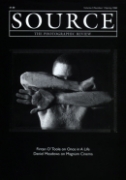Triúr Ban
Book Review by Lynne Connolly
Issue 7 Spring 1996
View Contents ▸
Published by: Gallery of Photography, Dublin
ISBN: 0952674107
Price: £50.00
Triúr Ban brings together the work of three artists; Cindy Cummings, Nuala Ni Dhomhnaill and Amelia Stein - respectively a performer, a poet and a photographer. It would however be more accurate to say that these three artists have collaboratively produced what is Triúr Ban. In this instance Triúr Ban is a book of poetry and black and white images of performance. But that's only the beginning. As Caoimhin Mac Giolla Leith states in the foreword, "their work is to some degree about the process of collaboration itself, about the perils and rewards of labouring together". Gobán
Gobán
Each artist is an independent author in that all the writing is by Ni Dhomhnaill, performance by Cummings and photography by Stein. But it is a process of collaboration which becomes the lynch-pin of the project. This way of working questions the role of the author and traditional understanding of the artist as an inspired but lonely genius. It is not about an exchange of skills but rather about the inter-reaction of them.
There is a sense of the book as performance. This exists in the multi-layering of the personal subject by Cummings. Through issues of aesthetics and beauty in Stein, complementary to the stress between her medium and its modes of representation. Between interpretation and its utterance in language by ni Dhomhnaill. These dynamics work together and change into something beyond their initial form. Each responds to the other. A poem may be inspired by an image, an image by a dance movement, a dance movement by a poem. Current and historic issues inform the work such as the 'X' case of 1992 when a fourteen year old girl was prevented by the state from travelling to London for an abortion after being raped.
The reader is guided but not necessarily directed by the relationship between image, subject and word. Ni Dhomhnaill offers a reading which can be complementary to or independent from the images. In Foidin Mearthail we get a taste of the enjoyment of language: "Hovering above the abyss, floating between two layers of water if I get a foothold barely on the ground, how do I know it won't be a stray sod...?"
The other poems which follow this engage the imagination and delight in the serious play of the collaboration. For example, Saoirse and the somewhat tongue in cheek Goban - "The worst gag is of our own doing... and it is to the side of the wall that I'm telling this!"
The images themselves are at once questioning and intriguing - this duplicity is mirrored in the unclear boundary between performer and photographer. For example Sile Na Gig, where Cummings takes on the stance of what is traditionally represented as a stone carving. The beauty and strength of her pose are well portrayed in the capable hands of Stein. The sharpness of the image, quality of tones and understanding of visual interpretation show a sympathy beyond the mere capturing of an image.
In Faoi Mar A Bhiodar, a series of seven images, Cummings back fills the frame. The surface of her skin is caked with a compacted white crust. Her hands stretch back, centred in the frame provided by the canvas of her body. They gesture as an offer of mute and difficult communication. These images are quietly disturbing and seductive, with poetry offering an interpretation, or is it inspiration?
"...they all came out of their mother's womb just as they were just as they will be from the smallest one to the biggest one and they all headed off towards the mouth of the tomb..."
For me it speaks of something with life dying and something with death living - it is a strong and moving piece of work.
Even as each artist contributes their own professional and creative excellence there is a collective engagement that steps out of the frame and pulls the viewer back in. These stances of performance with/to the camera do not answer questions but rather pose/pause for thought. The dynamic placed before the photographer and the writer are equally placed before the viewer with oscillating layers of understanding and interpretation. The process of collaboration presented here is continually open ended. There is a sense of balance in the aesthetic integrity of each artist. Perhaps as importantly there is a sense of allowing the work to find its own place in the wider context of its audience- the reader/viewer who then becomes a participant in the negotiation of meaning. Images and poetry do not ground each other but present various possible interpretations.
I for one find the images, performance and language of Triúr Ban a rich and pleasurable experience. This is slightly hampered by the limitation of the printed and bound medium of the book (which was produced to coincide with the exhibition Triúr Ban). Having enjoyed this I look forward to seeing the exhibition, for this is a collaboration which goes beyond bound covers. One slight problem I did encounter was as a non Gaelic speaker interpreting the titles and therefore having an understanding of any possible play of words and images there. Elsewhere all text is in both Irish and English. For any one interested in poetry, language, photography, body performance, Irish culture, history, politics and the beautifully fluid boundaries between these, then read/view on...
Other articles by Lynne Connolly:
Other articles on photography from the 'Performance' category ▸





